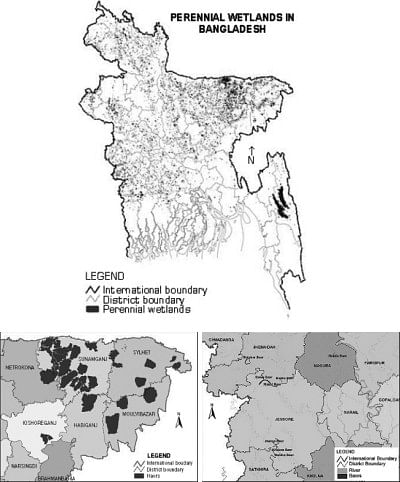An appraisal of fresh water wetlands

Map: Bangladesh Water Development Board (BWDB), Haors and Baors.
Bangladesh possesses enormous area of wetlands. Rivers and streams, freshwater lakes and marshes (haors, baors, beels), water storage reservoirs, fish ponds, flooded cultivated fields and estuarine systems with extensive mangrove swamps are varieties of wetland in Bangladesh. However, the haors, baors, beels and jheels are of fluvial origin and are commonly identified as freshwater wetlands. These wetlands occupy four landscape units -- floodplains, freshwater marshes, lakes and swamp forests which have a wide range of ecological, socio-cultural, economic and commercial importance and values in Bangladesh.
Haors: Haors are large saucer-shaped flood plain depressions located mostly in north-eastern region of the country covering about 25% of its entirety. There are altogether 411 haors comprising an area of about 8000 km2 dispersed in the districts of Sunamgonj, Sylhet, Moulvibazar, Hobigonj, Netrokona and Kishoreganj. The Haors are enriched with various aquatic flora and fauna including 140 species of fish. About 8000 migratory wild birds visit the area annually. The extreme flashy character of the rivers and high rain fall compared to other parts of the country cause frequent flash floods in the Haors. In Haor area three major resources viz. land, water and human could not be utilized in an integrated way due to its unique geographical as well as complex hydrological characteristics. Some of the important aspects to utilize the resource are to ensure harvesting of principal crop (Boro), enhancement of communication net works, multiple uses of water resources with emphasis on fishery, agriculture, cattle farming and employment opportunities for both men & women throughout the year.
Baors: Baor or Oxbow Lake a crescent-shaped lake formed when a river bank across the neck of a well-developed meander; it is found on the floodplain of a river. Oxbows are caused by the loops of meanders being cut-off at times by floods, causing the river subsequently to adopt a shorter course. In Bangladesh, oxbow lakes are quite visible in the older floodplains. Locally, the feature is also known as beel and jheel. Usually, oxbow lakes become plugged with sediment where they adjoin the channel and then progressively get filled in. These abandoned channels are rich in organic matters, because of profuse aquatic vegetation growth in clay to fine silty-clay sediments.
Usually, oxbow lakes are deeply flooded during the monsoon, either through local rainfall and runoff water or by river flood. Depending upon the depth of flooding, the rims of the lakes are used for boro rice cultivation, at least in the early stage. Once the lake gets filled with alluvium, it comes under rice cultivation. These lakes support a large variety of aquatic flora and fauna. Some of the lakes are considered to be very important freshwater fishing grounds, and are locally called jalmahal. During the monsoon season oxbow lakes act as local water reservoirs, and help to control the local flood level. In some areas, these lakes serve as valuable source of irrigation during the dry season.
Floodplains: Apart from the major river courses and streams, the major wetlands of fluvial origin occupy the floodplains. The manmade wetlands including ponds, dighis and lakes are distributed all over the floodplains. Some important wetlands of the country are chalan beel, Atrai basin, lower Punarbhaba floodplain, Gopalganj-Khulna Beels, Arial Beel, and Surma-Kushiyara floodplain.
Beels: In the active floodplains of the Surma-Meghna, the Brahmaputra-Jamuna, and the Ganges-Padma river systems, there are several large and small beels. Thousands of beels of different sizes. Some of the most commonly known are Chalan beel, Gopalganj-Khulna beel and Arial beel. Beel a large surface waterbody that accumulates surface runoff water through internal drainage channels; these depressions are mostly topographic lows produced by erosions and are seen all over Bangladesh. The term beel is synonymous to baor, and familiar in greater Comilla, Faridpur, Dhaka and Pabna districts. Beels are small saucer-like depressions of a marshy character. Many of the beels dry up in the winter but during the rains expand into broad and shallow sheets of water, which may be described as fresh water lagoons.
Degradation: Most of these large beels have shrunk quite considerably in recent decades. For instance, in the early 19th century Chalan Beel used to cover an area of about 1,085 sq km but it was reduced to 368 sq km by 1909, of which only 85 sq km remained under water throughout the year. It has since shrunk to only 26 sq km. Beels are mainly fed by surface runoff water. A few larger ones are fed by floodwater during the wet season from the parent river channel. Normally, beels remain deeply flooded for most of the wet season and the rims are primarily used for either boro cultivation or deepwater rice. Like baors, beels are also important wetlands and regarded as valuable fish and wildlife habitat.
Degradation of wetlands has caused several problems including extinction and reduction of wildlife, extinction of many indigenous wild and domesticated rice varieties, loss of many indigenous aquatic plants, herbs, shrubs and weeds, loss of natural soil nutrients, loss of natural water reservoirs and of their resultant benefits, increase in the occurrence of flooding and degeneration of wetland based ecosystems, occupations, socio-economic institutions and cultures.
Conclusion: There are a variety of wetlands in Bangladesh such as Haor, Baor and Beel, as said, that are open in nature and, on the other hand, channel wetlands such as river and canal. These are inland and fresh water wetlands critically important for human settlements, biodiversity, fisheries, agricultural diversity, navigation and communication, and ecotourism. It is a matter of regret that due to natural and human induced causes many of these wetlands are at the verge of extinction. Taking immediate and long term action against degradation of the country's wetlands is a crying need of time.
Mahfujur Rahman, an environmental reporter, can be reached at [email protected]

 For all latest news, follow The Daily Star's Google News channel.
For all latest news, follow The Daily Star's Google News channel. 



Comments